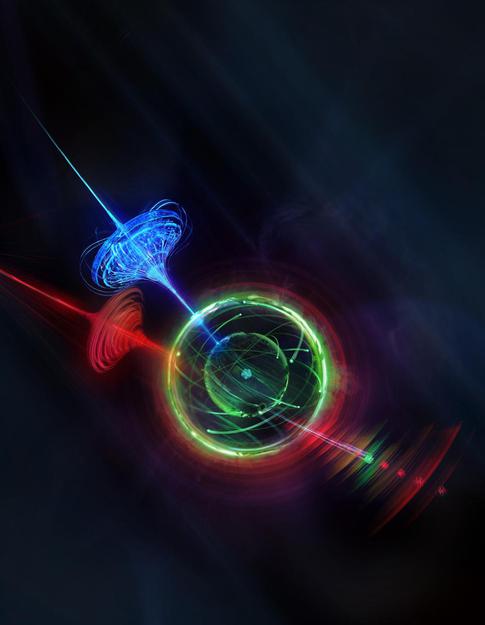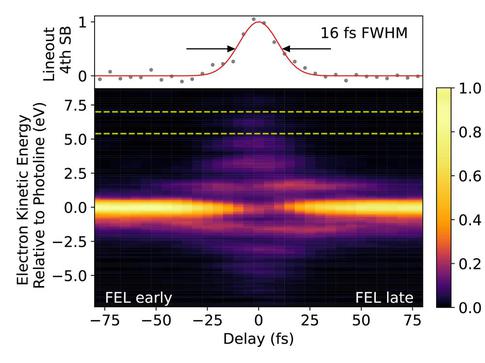XFEL: Record time resolution
https://www.xfel.eu/e35178/e35455/e35456
https://www.xfel.eu/news_and_events/news/index_eng.html
news
news
news
eng
1
1
10
both
0
1
%Y/%m/%d
Press-Release
eng,ger

 After being illuminated with light, the atoms in materials react within femtoseconds, i.e. quadrillionths of a second. To observe these reactions in real time, the experiment setup used to capture them must operate with femtosecond time resolution too, otherwise the resulting images will be “blurred”. In a proof-of-principle experiment at the European XFEL, a research team has demonstrated a record time resolution of around 15 femtoseconds—the best resolution reported so far in a pump–probe experiment at an X-ray free-electron laser (FEL) facility, while keeping a high spectral resolution. “These results open up the possibility of doing time-resolved experiments with unprecedented time resolution, enabling the observation of ultrafast processes in materials that were not accessible before,” explains Daniel Rivas from European XFEL, principal investigator of the experiment and first author of the publication in the scientific journal Optica, in which the team from European XFEL and the DESY research centre in Hamburg report their results.
After being illuminated with light, the atoms in materials react within femtoseconds, i.e. quadrillionths of a second. To observe these reactions in real time, the experiment setup used to capture them must operate with femtosecond time resolution too, otherwise the resulting images will be “blurred”. In a proof-of-principle experiment at the European XFEL, a research team has demonstrated a record time resolution of around 15 femtoseconds—the best resolution reported so far in a pump–probe experiment at an X-ray free-electron laser (FEL) facility, while keeping a high spectral resolution. “These results open up the possibility of doing time-resolved experiments with unprecedented time resolution, enabling the observation of ultrafast processes in materials that were not accessible before,” explains Daniel Rivas from European XFEL, principal investigator of the experiment and first author of the publication in the scientific journal Optica, in which the team from European XFEL and the DESY research centre in Hamburg report their results.
One of the goals of experiments at the European XFEL is to record “molecular movies”, i.e. series of snapshots of dynamic processes taken in extremely rapid succession, which reveal the details of chemical reactions or physical changes in materials at high time resolution. Understanding the molecular rearrangement during such reactions is an essential step towards controlling processes in our natural environment, such as radiation damage in biological systems or photochemical and catalytic reactions. One technique to create such movies is pump–probe spectroscopy, where an optical laser pulse (the “pump” pulse) excites a certain process in a sample and the X-ray laser pulses (the “probe” pulses) are used to take a series of snapshots in order to observe how the process evolves in time.
The time resolution of a pump–probe measurement is determined by the duration of the laser pump pulse, the duration of the probing X-ray pulse, and the relative synchronization between them. “Synchronization is particularly challenging,” emphasizes Rivas. “If we translate the timing synchronization we need into distances, we end up with a required precision of only a few micrometres along a 3.4-kilometre-long facility! This is a formidable challenge, as mechanical vibrations and changes in the environmental conditions can already significantly vary the path travelled by the laser, the accelerated electrons, or the X-ray photons.” The variations lead to an uncertainty in the arrival time at the experiment, called the timing jitter, which smears out the molecular movie of the process under study.
For their time resolution demonstration, the team used a combination of several technical advancements made at European XFEL and DESY, including a specially designed, ultrashort-pulse optical laser system, the facility-wide optical synchronization system, and X-ray emission specifically tuned for 10-femtosecond pulse durations. As the final key ingredient, the team realized that the residual timing jitter came mainly from fluctuations in the acceleration process of the electrons before they emit the X-ray pulses. Thanks to new electron arrival time monitors, the researchers were able to measure these fluctuations in a non-invasive manner and later correct their molecular movies accordingly.
The experiment at the SQS (Small Quantum Systems) instrument of the European XFEL consisted in measuring the “duration” of an instantaneous effect that occurs when an atom is ionized by X-rays in the presence of an optical laser. Only when the optical pulse and the X-ray pulse overlap in time will the emitted X-ray photoelectrons be modulated in energy, as shown in the figure. From the measurement of how long both pulses seemed to fully overlap, the team determined an overall time resolution of only 16 ± 2 femtoseconds for this four-optical-photon process, which is unprecedented at X-ray FEL facilities.
“It is important to emphasize that the systems required for these experiments are non-invasive, in contrast to other measure-and-sort approaches that only work under very specific FEL conditions,” explains Michael Meyer, leader of the SQS instrument group, who supervised the experiment. “Thanks to this novel approach, we will be able to offer these great capabilities together with full flexibility of the X-ray FEL and laser parameters to our users.”
2022/04/11
Back
Record time resolution
Research team demonstrates best pump–probe time resolution reported so far at X-ray free-electron laser facilities

Download [1.6 MB, 2746 x 3543]
An ultrashort X-ray pulse and an optical laser pulse interact simultaneously with a neon atom. The X-ray pulse removes an electron from the inner electronic shell and, due to the electromagnetic field of the optical laser that is present at the moment of ionization, the outcoming electron is modulated in energy. Copyright: illustratoren.de/TobiasWuestefeld in cooperation with European XFEL
An ultrashort X-ray pulse and an optical laser pulse interact simultaneously with a neon atom. The X-ray pulse removes an electron from the inner electronic shell and, due to the electromagnetic field of the optical laser that is present at the moment of ionization, the outcoming electron is modulated in energy. Copyright: illustratoren.de/TobiasWuestefeld in cooperation with European XFEL

Download [650KB, 1920 x 1440]
Relative kinetic energy of the electrons as a function of the delay between the X-ray and optical laser pulses. When both pulses overlap (delay = 0 fs), the electron energy shows the highest modulation. This time window of maximum overlap has a duration of only 16 ± 2 fs (full width at half maximum), which corresponds to the respective time resolution obtained from the experiment. Copyright: illustratoren.de/TobiasWuestefeld in cooperation with European XFEL
Relative kinetic energy of the electrons as a function of the delay between the X-ray and optical laser pulses. When both pulses overlap (delay = 0 fs), the electron energy shows the highest modulation. This time window of maximum overlap has a duration of only 16 ± 2 fs (full width at half maximum), which corresponds to the respective time resolution obtained from the experiment. Copyright: illustratoren.de/TobiasWuestefeld in cooperation with European XFEL
One of the goals of experiments at the European XFEL is to record “molecular movies”, i.e. series of snapshots of dynamic processes taken in extremely rapid succession, which reveal the details of chemical reactions or physical changes in materials at high time resolution. Understanding the molecular rearrangement during such reactions is an essential step towards controlling processes in our natural environment, such as radiation damage in biological systems or photochemical and catalytic reactions. One technique to create such movies is pump–probe spectroscopy, where an optical laser pulse (the “pump” pulse) excites a certain process in a sample and the X-ray laser pulses (the “probe” pulses) are used to take a series of snapshots in order to observe how the process evolves in time.
The time resolution of a pump–probe measurement is determined by the duration of the laser pump pulse, the duration of the probing X-ray pulse, and the relative synchronization between them. “Synchronization is particularly challenging,” emphasizes Rivas. “If we translate the timing synchronization we need into distances, we end up with a required precision of only a few micrometres along a 3.4-kilometre-long facility! This is a formidable challenge, as mechanical vibrations and changes in the environmental conditions can already significantly vary the path travelled by the laser, the accelerated electrons, or the X-ray photons.” The variations lead to an uncertainty in the arrival time at the experiment, called the timing jitter, which smears out the molecular movie of the process under study.
For their time resolution demonstration, the team used a combination of several technical advancements made at European XFEL and DESY, including a specially designed, ultrashort-pulse optical laser system, the facility-wide optical synchronization system, and X-ray emission specifically tuned for 10-femtosecond pulse durations. As the final key ingredient, the team realized that the residual timing jitter came mainly from fluctuations in the acceleration process of the electrons before they emit the X-ray pulses. Thanks to new electron arrival time monitors, the researchers were able to measure these fluctuations in a non-invasive manner and later correct their molecular movies accordingly.
The experiment at the SQS (Small Quantum Systems) instrument of the European XFEL consisted in measuring the “duration” of an instantaneous effect that occurs when an atom is ionized by X-rays in the presence of an optical laser. Only when the optical pulse and the X-ray pulse overlap in time will the emitted X-ray photoelectrons be modulated in energy, as shown in the figure. From the measurement of how long both pulses seemed to fully overlap, the team determined an overall time resolution of only 16 ± 2 femtoseconds for this four-optical-photon process, which is unprecedented at X-ray FEL facilities.
“It is important to emphasize that the systems required for these experiments are non-invasive, in contrast to other measure-and-sort approaches that only work under very specific FEL conditions,” explains Michael Meyer, leader of the SQS instrument group, who supervised the experiment. “Thanks to this novel approach, we will be able to offer these great capabilities together with full flexibility of the X-ray FEL and laser parameters to our users.”
Publication:
Daniel E. Rivas et al.: “High-temporal-resolution X-ray spectroscopy with free-electron and optical lasers”, Optica 9, 429–433 (2022)
doi:10.1364/optica.454920
Further information:
Daniel Rivas
European XFEL
daniel.rivas@xfel.eu
Michael Meyer
European XFEL
michael.meyer@xfel.eu
